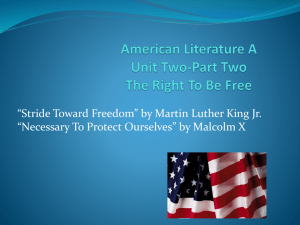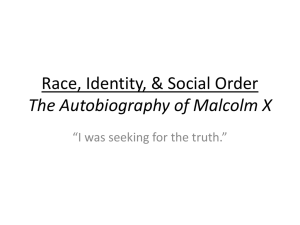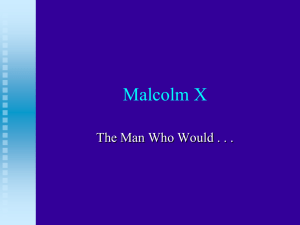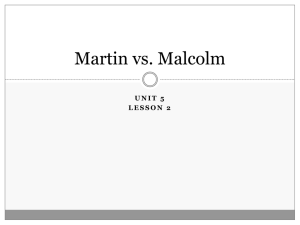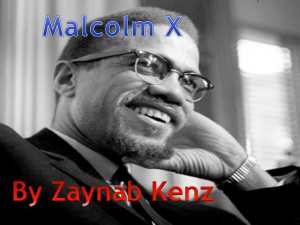Learning Sequence
advertisement
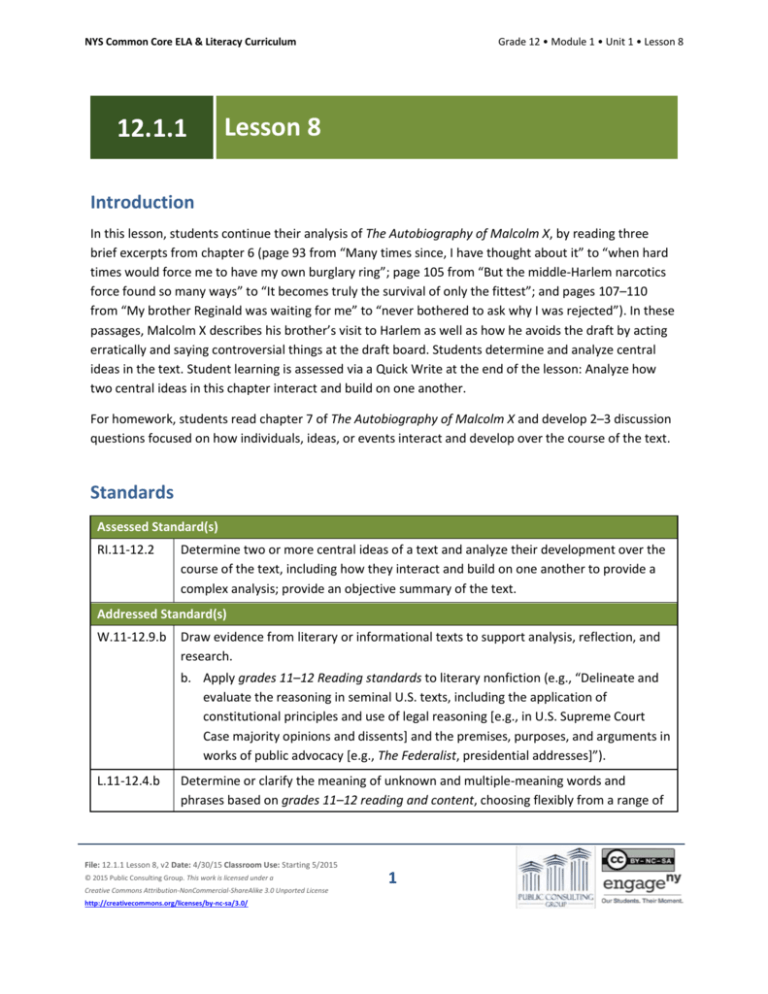
NYS Common Core ELA & Literacy Curriculum 12.1.1 Grade 12 • Module 1 • Unit 1 • Lesson 8 Lesson 8 Introduction In this lesson, students continue their analysis of The Autobiography of Malcolm X, by reading three brief excerpts from chapter 6 (page 93 from “Many times since, I have thought about it” to “when hard times would force me to have my own burglary ring”; page 105 from “But the middle-Harlem narcotics force found so many ways” to “It becomes truly the survival of only the fittest”; and pages 107–110 from “My brother Reginald was waiting for me” to “never bothered to ask why I was rejected”). In these passages, Malcolm X describes his brother’s visit to Harlem as well as how he avoids the draft by acting erratically and saying controversial things at the draft board. Students determine and analyze central ideas in the text. Student learning is assessed via a Quick Write at the end of the lesson: Analyze how two central ideas in this chapter interact and build on one another. For homework, students read chapter 7 of The Autobiography of Malcolm X and develop 2–3 discussion questions focused on how individuals, ideas, or events interact and develop over the course of the text. Standards Assessed Standard(s) RI.11-12.2 Determine two or more central ideas of a text and analyze their development over the course of the text, including how they interact and build on one another to provide a complex analysis; provide an objective summary of the text. Addressed Standard(s) W.11-12.9.b Draw evidence from literary or informational texts to support analysis, reflection, and research. b. Apply grades 11–12 Reading standards to literary nonfiction (e.g., “Delineate and evaluate the reasoning in seminal U.S. texts, including the application of constitutional principles and use of legal reasoning [e.g., in U.S. Supreme Court Case majority opinions and dissents] and the premises, purposes, and arguments in works of public advocacy [e.g., The Federalist, presidential addresses]”). L.11-12.4.b Determine or clarify the meaning of unknown and multiple-meaning words and phrases based on grades 11–12 reading and content, choosing flexibly from a range of File: 12.1.1 Lesson 8, v2 Date: 4/30/15 Classroom Use: Starting 5/2015 © 2015 Public Consulting Group. This work is licensed under a Creative Commons Attribution-NonCommercial-ShareAlike 3.0 Unported License http://creativecommons.org/licenses/by-nc-sa/3.0/ 1 NYS Common Core ELA & Literacy Curriculum Grade 12 • Module 1 • Unit 1 • Lesson 8 strategies. b. Identify and correctly use patterns of word changes that indicate different meanings or parts of speech (e.g., conceive, conception, conceivable). Assessment Assessment(s) Student learning is assessed via a Quick Write at the end of the lesson. Students respond to the following prompt, citing textual evidence to support analysis and inferences drawn from the text. Analyze how two central ideas in this chapter interact and build on one another. High Performance Response(s) A High Performance Response should: Identify two central ideas in the chapter (e.g., systemic oppression and racial identity). Analyze how the two central ideas interact and build on one another (e.g., In this chapter Malcolm X discusses the central idea of systemic oppression. He writes that African Americans in Harlem were “black victims of the white man’s American social system” (p. 93) and were forced to engage in criminal activity in order to survive. Later in the chapter he develops this idea with the metaphor of survival among animals to demonstrate the effects of oppression. This idea interacts with the idea of racial identity in Malcolm X’s discussion of “Negro ‘firsts’” (p. 109), which Malcolm X describes as African Americans who were among the first to do a certain job. The concept of “Negro ‘firsts’” demonstrates the central ideas of racial identity and systemic oppression by showing that while the white social system forced most African Americans into poverty, during extreme times like war, the same system allowed some African Americans to attain better jobs. Even though the attainment of these better jobs seems positive, Malcolm X argues that the creation of “Negro ‘firsts’” actually helped to reinforce a negative racial identity for African Americans. Malcolm X argues that those African Americans who became “Negro ‘firsts’” (p. 109) were just like the “‘upper-class’ Negroes” (p. 109) of his time who are “so busy trying to impress on the white man that they are ‘different from those others’ that they can’t see they are only helping the white man to keep his low opinion of all Negroes” (p. 109). Therefore, the effects of systemic oppression can cause people to have a negative racial identity.). File: 12.1.1 Lesson 8, v2 Date: 4/30/15 Classroom Use: Starting 5/2015 © 2015 Public Consulting Group. This work is licensed under a Creative Commons Attribution-NonCommercial-ShareAlike 3.0 Unported License http://creativecommons.org/licenses/by-nc-sa/3.0/ 2 NYS Common Core ELA & Literacy Curriculum Grade 12 • Module 1 • Unit 1 • Lesson 8 Vocabulary Vocabulary to provide directly (will not include extended instruction) archetype (n.) – a constantly recurring symbol or motif in literature, painting, etc. siphoned (v.) – passed or drew off through or as if through a tube spiel (v.) – to speak volubly or extravagantly Vocabulary to teach (may include direct word work and/or questions) vinegary (adj.) – having a disagreeable character or manner hedged (v.) – avoided giving a promise or direct answer Additional vocabulary to support English Language Learners (to provide directly) prospective (adj.) – likely to be or become something specified in the future smug (adj.) – having or showing the annoying quality of people who feel very pleased or satisfied with their abilities, achievements, etc. Lesson Agenda/Overview Student-Facing Agenda % of Lesson Standards & Text: Standards: RI.11-12.2, W.11-12.9.b, L.11-12.4.b Text: The Autobiography of Malcolm X as told to Alex Haley, Chapter 6, pages 97, 105, and 107–110 Learning Sequence: 1. 2. 3. 4. 5. Introduction of Lesson Agenda Homework Accountability Reading and Discussion Quick Write Closing 1. 2. 3. 4. 5. File: 12.1.1 Lesson 8, v2 Date: 4/30/15 Classroom Use: Starting 5/2015 © 2015 Public Consulting Group. This work is licensed under a Creative Commons Attribution-NonCommercial-ShareAlike 3.0 Unported License http://creativecommons.org/licenses/by-nc-sa/3.0/ 3 5% 20% 55% 15% 5% NYS Common Core ELA & Literacy Curriculum Grade 12 • Module 1 • Unit 1 • Lesson 8 Materials Student copies of the Central Ideas Tracking Tool (refer to 12.1.1 Lesson 4) (optional) )—students may need additional blank copies Student copies of the Short Response Rubric and Checklist (refer to 12.1.1 Lesson 1) Learning Sequence How to Use the Learning Sequence Symbol Type of Text & Interpretation of the Symbol 10% no symbol Percentage indicates the percentage of lesson time each activity should take. Plain text indicates teacher action. Bold text indicates questions for the teacher to ask students. Italicized text indicates a vocabulary word. Indicates student action(s). Indicates possible student response(s) to teacher questions. Indicates instructional notes for the teacher. Activity 1: Introduction of Lesson Agenda 5% Begin by reviewing the agenda and the assessed standard for this lesson: RI.11-12.2. In this lesson, students continue to read and analyze The Autobiography of Malcolm X. Students read three brief excerpts from chapter 6 and focus on how central ideas in the text build and interact on one another. Students look at the agenda. Activity 2: Homework Accountability 20% Instruct students to take out their responses to the previous lesson’s homework assignment. (Read and annotate chapter 6 of The Autobiography of Malcolm X and develop 2–3 discussion questions focused on how central ideas develop, interact, or build on one another in the text (RI.11-12.2). Prepare possible answers to your questions for discussion. Also, write a one-paragraph summary of the text through chapter 6, focusing on how Malcolm X’s character has developed over the course of the text.) Instruct students to talk in pairs about the summaries they developed for homework. Malcolm X’s character has developed from his early years in Lansing, Michigan, where his family is forced to move after they are attacked by white racists. Malcolm X is as bright or brighter than his white classmates in Lansing, but because he is African American, his teacher tells him that he File: 12.1.1 Lesson 8, v2 Date: 4/30/15 Classroom Use: Starting 5/2015 © 2015 Public Consulting Group. This work is licensed under a Creative Commons Attribution-NonCommercial-ShareAlike 3.0 Unported License http://creativecommons.org/licenses/by-nc-sa/3.0/ 4 NYS Common Core ELA & Literacy Curriculum Grade 12 • Module 1 • Unit 1 • Lesson 8 can’t be a lawyer. From a young age, therefore, Malcolm X is aware of how racism negatively affects African Americans. Malcolm X grows restless and tired of living with whites, so he takes the opportunity to move from Lansing to live with his sister in Boston. There, he adopts the lifestyle of a “hipster” and attends parties and dances. Malcolm X identifies more with the working class African Americans rather than the wealthier ones on the Hill. But Malcolm X is still restless, so he goes to Harlem. There he feels like he has found the place where he truly belongs. Although Malcolm X is deeply involved in a life of crime, he continues to demonstrate his intelligence, using his mind to win battles against others, particularly whites who don’t give credit to African Americans’ intelligence. Malcolm X focuses his energy and intelligence on survival in a racist society. Instruct students to talk in pairs about the questions they developed for homework, specifically analyzing central ideas that emerged in earlier chapters and continued in this section of the text, and how they relate to ideas in this chapter (RI.11-12.2). Student questions may include: On page 106, in the paragraph beginning “In New York, I rolled and packed,” how does Malcolm X develop a central idea of the text? Malcolm X describes how he could persuade a “conductor [he was] a fellow employee who had to go home on some family business” (p. 106) and be able to ride the railroad for free. Referring to the white conductor, Malcolm X states, “Most whites don’t give a Negro credit for having sense enough to fool them—or nerve enough” (p. 106). Here, Malcolm X develops the idea of racial identity by showing a white sense of superiority over African Americans whom white people judge as lesser. On page 105, in the paragraph beginning “Now, every other day or so, usually in some public place,” how does the Malcolm X’s description of the situation in Harlem develop a central idea? Malcolm X states, “Negroes were starting to get very tense in Harlem. One could almost smell trouble ready to break out—as it did very soon” (p. 105). Here Malcolm X develops the idea of systemic oppression. By hinting that trouble was “ready to break out” between the residents of Harlem and the police, Malcolm X develops the idea of how oppression affects the African Americans in Harlem. The residents of Harlem “already thought little enough of the law” (p. 105), he writes, indicating that the African Americans who lived there viewed the police and authority figures as forces set against them. If student discussion is rich, text-dependent, and building toward the assessment prompt, consider extending the discussions beyond the allotted time. Then lead a brief whole-class discussion using File: 12.1.1 Lesson 8, v2 Date: 4/30/15 Classroom Use: Starting 5/2015 © 2015 Public Consulting Group. This work is licensed under a Creative Commons Attribution-NonCommercial-ShareAlike 3.0 Unported License http://creativecommons.org/licenses/by-nc-sa/3.0/ 5 NYS Common Core ELA & Literacy Curriculum Grade 12 • Module 1 • Unit 1 • Lesson 8 any additional Reading and Discussion questions necessary to ensure students are prepared for the assessment. (Key questions are marked with an asterisk*.) Activity 3: Reading and Discussion 55% Instruct students to form small groups. Post or project each set of questions below for students to discuss. Instruct students to continue to annotate the text as they read and discuss. Instruct students to read the three paragraphs on page 93 (from “Many times since, I have thought about it” to “when hard times would force me to have my own burglary ring”) and answer the following questions before sharing out with the class. Remind students to annotate for central ideas (CI). Consider reminding students that this use of focused annotation supports their engagement with W.11-12.9.b, which addresses the use of textual evidence in writing. Differentiation Consideration: Students may use their Central Ideas Tracking Tools to record central ideas they identify and discuss. If necessary to support comprehension and fluency, consider using a masterful reading of the focus excerpt for the lesson. Differentiation Consideration: Consider posting or projecting the following guiding question to support students in their reading throughout this lesson: What is Malcolm X’s opinion about why so many African Americans have to struggle to survive? *Explain the “‘there but for the grace of God’ symbol” (p. 93). How does this symbol relate to the “wolves” metaphor? Malcolm X states that to “wolves who still were able to catch some rabbits, it had meaning that an old wolf who had lost his fangs was still eating” (p. 93). In this metaphor, the wolves are the hustlers gathered at the bar and the “old wolf” (p. 93) is the man for whom the others buy drinks and food. This man, who is no longer able to “hustle” (p. 93), on his own serves as a symbol for the others who would be “‘there but for the grace of God’” (p. 93), meaning that they could be in his situation if not for the help of God. How does the story of Jumpsteady develop a central idea in the text? Jumpsteady, a burglar who used to jump from building to building to complete his robberies, is one of the “black victims of the white man’s American social system” (p. 93). This story develops the idea of systemic oppression by showing how Jumpsteady is a “victim” of the social system File: 12.1.1 Lesson 8, v2 Date: 4/30/15 Classroom Use: Starting 5/2015 © 2015 Public Consulting Group. This work is licensed under a Creative Commons Attribution-NonCommercial-ShareAlike 3.0 Unported License http://creativecommons.org/licenses/by-nc-sa/3.0/ 6 NYS Common Core ELA & Literacy Curriculum Grade 12 • Module 1 • Unit 1 • Lesson 8 created by whites, because he is denied other opportunities and forced to view “everyday living as survival” (p. 93). Consider reminding students of their work with the central idea of systemic oppression in 12.1.1 Lesson 4. Lead a brief whole-class discussion of student responses. Instruct students to read the paragraph on page 105 (from “But the middle-Harlem narcotics force found so many ways” to “It becomes truly the survival of only the fittest”) and answer the following questions before sharing out with the class. *How do Malcolm X’s descriptions of the “reefer smokers” on page 105 further develop a central idea? Malcolm X states that the “reefer smokers” had “the instincts of animals” and if he dropped his “stuff” they “would be on it like a chicken on corn” (p. 105). Malcolm X compares the situation of the drug users and himself to that of animals: “When you become an animal, a vulture, in the ghetto, as I had become, you enter a world of animals and vultures. It becomes truly the survival of only the fittest” (p. 105). According to Malcolm X, among the drug users, dealers, and other criminals, only the strong and ruthless are able to survive. By comparing African American drug addicts to animals, Malcolm X develops the idea that systemic oppression affects the AfricanAmerican community. The drug addicts who live in a ghetto created by the white social structure lose their humanity and “become … animal[s]” because they are denied decent employment opportunities (p. 105). Differentiation Consideration: Consider posing the following extension question to allow for a more detailed discussion of style in the text: How does this metaphor contribute to the power of the text? How does it develop an idea introduced earlier in the chapter, on page 93? This metaphor contributes power to the text by describing drug dealers and addicts as animals and, thus, Malcolm X powerfully conveys his point about how the ghetto destroys African Americans’ lives. Malcolm X uses the metaphor to highlight how poverty and drugs have taken away their humanity. The metaphor demonstrates in vivid imagery how some African Americans can only hope to “survive” in “the worst of the ghetto” (p. 105) rather than live and thrive in the world. In this way, the metaphor of the drug users living as “animals and vultures” develops the idea from page 93 that African Americans were not able to “aspire to greater things, but to view everyday living as survival” (p. 93). File: 12.1.1 Lesson 8, v2 Date: 4/30/15 Classroom Use: Starting 5/2015 © 2015 Public Consulting Group. This work is licensed under a Creative Commons Attribution-NonCommercial-ShareAlike 3.0 Unported License http://creativecommons.org/licenses/by-nc-sa/3.0/ 7 NYS Common Core ELA & Literacy Curriculum Grade 12 • Module 1 • Unit 1 • Lesson 8 Lead a brief whole-class discussion of student responses. Differentiation Consideration: Students may use their Central Ideas Tracking Tools to record central ideas they identified and discussed. Instruct students to read pages 107–108 (from “My brother Reginald was waiting for me” to “in care of Sammy, I received Uncle Sam’s Greetings”) and answer the following questions before sharing out with the class. How does Malcolm X’s description of his brother’s visit develop Malcolm X’s character in this excerpt? Student responses may include: o o o Malcolm X compares himself to his brother and finds that Reginald was “a lot more selfpossessed” (p. 107) than Malcolm X was at 16. This example shows how Malcolm X has matured and gained some humility since his experiences as the young man who worked on the trains and was so rude that the old-timers said about him, “‘Man, you can’t tell him nothing!’” (p. 81). Malcolm X gives Reginald advice about dressing more conservatively, because as he states, “in order to get something you had to look as though you already had something” (p. 108). This example shows how Malcolm X is beginning to dress and act differently from the days when he first came to Harlem and dressed in “wild zoot suit[s]” (p. 108). Malcolm X also states that he was pleased to see that Reginald “admired my living by my wits” (p. 107), which develops Malcolm X’s character by showing how he is proud during this time that he is able to earn a living as a “hustler,” and is happy when others admire him for it. Lead a brief whole-class discussion of student responses. Instruct students to read pages 108–110 (from “In those days only three things in the world scared me” to “never bothered to ask why I was rejected”) and answer the following questions before sharing out with the class. Provide students with the following definitions: archetype means “a constantly recurring symbol or motif in literature, painting, etc.,” siphoned means “passed or drew off through or as if through a tube,” and spiel means “to speak volubly or extravagantly.” Students may be familiar with these words. Consider asking students to volunteer the definitions before providing it to the class. File: 12.1.1 Lesson 8, v2 Date: 4/30/15 Classroom Use: Starting 5/2015 © 2015 Public Consulting Group. This work is licensed under a Creative Commons Attribution-NonCommercial-ShareAlike 3.0 Unported License http://creativecommons.org/licenses/by-nc-sa/3.0/ 8 NYS Common Core ELA & Literacy Curriculum Grade 12 • Module 1 • Unit 1 • Lesson 8 Students write the definitions of archetype, siphoned, and spiel on their copies of the text or in a vocabulary journal. Differentiation Consideration: Consider providing students with the following definitions: prospective means “likely to be or become something specified in the future” and smug means “having or showing the annoying quality of people who feel very pleased or satisfied with their abilities, achievements, etc.” Students write the definitions of prospective and smug on their copies of the text or in a vocabulary journal. Why do some of the white soldiers have “that vinegary ‘worst kind of nigger’ look” at Malcolm X (p. 109)? What word can you identify in vinegary to help you determine its meaning? Student responses should include: o o These white soldiers cannot tell that Malcolm X is play-acting. They think he is “the worst kind” of African American and are disgusted by him. Vinegary contains the word vinegar, which is a sour liquid. Malcolm X uses the word vinegary to describe how some of the angry white people at the draft office were looking at him. Therefore, in this context, vinegary is a way of describing a person who is making a sour face like they have just tasted vinegar. Consider drawing students’ attention to their application of standard L.11-12.4.b through the process of using word patterns and parts to make meaning of a word. *What is a “Negro ‘first[]’” (p. 109)? How does Malcolm X’s description of this concept develop a central idea in the text? Student responses may include: o Malcolm X explains “Negro ‘firsts’” by describing how once the war started “the white man … began letting some Negroes put down their buckets and mops and dust rags and use a pencil” (p. 109) and begin working as a nurse or as a receptionist, for example. He states, “You couldn’t read the Negro press for the big pictures of smug black ‘firsts’” (p. 109). Malcolm X’s use of the word smug as well as the mention that these workers held “some twenty-five cent title” (p. 109) shows that he viewed these positions of “Negro ‘firsts’” negatively. These descriptions develop the central idea of racial identity. Malcolm X argues that these “Negro ‘firsts’” are actually demeaning because they create a second class of African Americans that “only help[] the white man to keep his low opinion of all Negroes” (p. 109). The concept of “Negro ‘firsts’” was actually supporting the racial identity of white File: 12.1.1 Lesson 8, v2 Date: 4/30/15 Classroom Use: Starting 5/2015 © 2015 Public Consulting Group. This work is licensed under a Creative Commons Attribution-NonCommercial-ShareAlike 3.0 Unported License http://creativecommons.org/licenses/by-nc-sa/3.0/ 9 NYS Common Core ELA & Literacy Curriculum o Grade 12 • Module 1 • Unit 1 • Lesson 8 people who thought they were superior, while demeaning the racial identity of African Americans by creating divisions among them. The concept of “Negro ‘firsts,’” which Malcolm X describes as African Americans who were among the first to do a certain job, supports the idea of systemic oppression, since the description implies control by the white social structure: “the white man during the war … began letting some Negroes put down their buckets and mops and dust rags and use a pencil” (p. 109). Malcolm X argues that the positions of “Negro ‘firsts’” were created and controlled by white people and not as meaningful as African Americans assumed, since they weren’t a genuine sign of respect but a result of necessity. Consider reminding students of their work with the central idea of racial identity in 12.1.1 Lesson 4. What does the following line suggest about how Malcolm X interacts with the psychiatrist: “I circled and hedged, watching him closely, to let him think he was pulling what he wanted out of me” (p. 110)”? What does the word hedged mean in this context? Student responses may include: o o Malcolm X describes himself as controlling the interaction by acting the part of an erratic hipster. “I knew I had him,” Malcolm X states, after he tells the psychiatrist how he is going to organize other African Americans to “‘ [s]teal us some guns, and kill us crackers!’” (p. 110). Malcolm X is able to get what he wants out of the psychiatrist, which is the decision that he shouldn’t be drafted because the psychiatrist thinks that he is unfit for the draft. Malcolm X states that when the psychiatrist asked “quiet questions, to get at why I was so anxious,” Malcolm X “circled and hedged” with the psychiatrist, and “didn’t rush him” (p. 110). These words and phrases describe how Malcolm X was not directly answering the psychiatrist, so it seems hedged means to avoid being direct with someone. What other episodes does this interaction with the Army psychiatrist recall in the text? Student responses may include: o o This example of Malcolm X outsmarting a white Army psychiatrist recalls the episode in which Malcolm X was challenged to a fight by a white passenger and embarrassed the passenger by making him take off almost all of his clothes. Malcolm X said about that episode, “I never would forget that—that I couldn’t have whipped that white man as badly with a club as I had with my mind” (p. 81). This episode recalls how Malcolm X was able to outsmart the white conductors in order to ride the railroad for free. Malcolm X states that he was able to fool the conductor because “[m]ost whites don’t give a Negro credit for having sense enough to fool them—or nerve enough” (p. 106). File: 12.1.1 Lesson 8, v2 Date: 4/30/15 Classroom Use: Starting 5/2015 © 2015 Public Consulting Group. This work is licensed under a Creative Commons Attribution-NonCommercial-ShareAlike 3.0 Unported License http://creativecommons.org/licenses/by-nc-sa/3.0/ 10 NYS Common Core ELA & Literacy Curriculum Grade 12 • Module 1 • Unit 1 • Lesson 8 How does Malcolm X’s interaction with the Army psychiatrist develop the idea of racial identity in the text? The psychiatrist dismisses Malcolm X when he brings up the threat of an African American revolt: “‘Organize them nigger soldiers, you dig? Steal us some guns, and kill us crackers!’” (p. 110). This incident develops the idea of racial identity by showing the fear with which the white psychiatrist viewed this threat from African Americans. Lead a brief whole-class discussion of student responses. Differentiation Consideration: Students may use their Central Ideas Tracking Tools to record central ideas they identified and discussed. Activity 4: Quick Write 15% Instruct students to respond briefly in writing to the following prompt: Analyze how two central ideas in this chapter interact and build on one another. Instruct students to look at their annotations and to find evidence. Ask students to use this lesson’s vocabulary wherever possible in their written responses. Remind students to use the Short Response Rubric and Checklist to guide their written responses. Students listen and read the Quick Write prompt. Display the prompt for students to see, or provide the prompt in hard copy. If necessary, remind students to use their notes from the previous night’s homework to provide evidence and assist in their understanding of how two central ideas interact and build on one another over the course of chapter. Transition to the independent Quick Write. Students independently answer the prompt using evidence from the text. See the High Performance Response at the beginning of this lesson. Activity 5: Closing 5% Display or distribute the homework assignment. For homework, instruct students to read and annotate chapter 7 of The Autobiography of Malcolm X and develop 2–3 discussion questions focused on how individuals, ideas, or events interact and develop over the course of the text (RI.11-12.3). Instruct students to prepare possible answers to their questions for discussion. File: 12.1.1 Lesson 8, v2 Date: 4/30/15 Classroom Use: Starting 5/2015 © 2015 Public Consulting Group. This work is licensed under a Creative Commons Attribution-NonCommercial-ShareAlike 3.0 Unported License http://creativecommons.org/licenses/by-nc-sa/3.0/ 11 NYS Common Core ELA & Literacy Curriculum Grade 12 • Module 1 • Unit 1 • Lesson 8 Differentiation Consideration: Students may use their Character Development Tools from 12.1.1 Lesson 3 to record Malcolm X’s character development through chapter 7. Consider asking students to focus on the different names Malcolm X is called throughout the first chapters of the text. Students follow along. For their Accountable Independent Writing homework, instruct students to continue drafting their personal narratives. Students may continue the draft they have been working on or choose to respond to a new Common Application prompt that better allows them to achieve their statements of purpose. Remind students to focus on engaging and orienting the reader by setting out a problem, situation, or observation and its significance; establishing one or multiple point(s) of view; introducing a narrator and/or characters; and creating a smooth progression of experiences or events. Students may post their drafts to the class’s online writing community and be paired for peer review. Remind peer reviewers to consider how effectively their peer engages and orients the reader by setting out a problem, situation, or observation and its significance; establishes one or multiple point(s) of view; introduces a narrator and/or characters; and creates a smooth progression of experiences or events. Consider maintaining the same peer review pairs through 12.1.1 Lesson 12 so that students can provide and receive consistent feedback from a peer familiar with their work in relation to W.1112.3.a. Homework For homework, read and annotate chapter 7 of The Autobiography of Malcolm X and develop 2–3 discussion questions focused on how individuals, ideas, or events interact and develop over the course of the text (RI.11-12.3). Prepare possible answers to your questions for discussion. File: 12.1.1 Lesson 8, v2 Date: 4/30/15 Classroom Use: Starting 5/2015 © 2015 Public Consulting Group. This work is licensed under a Creative Commons Attribution-NonCommercial-ShareAlike 3.0 Unported License http://creativecommons.org/licenses/by-nc-sa/3.0/ 12 NYS Common Core ELA & Literacy Curriculum Grade 12 • Module 1 • Unit 1 • Lesson 8 Model Central Ideas Tracking Tool Name: Class: Date: Directions: Identify the central ideas that you encounter throughout the text. Trace the development of those ideas by noting how the author introduces, develops, or refines these ideas in the texts. Cite textual evidence to support your work. Text: The Autobiography of Malcolm X as told to Alex Haley Page # Central Idea Notes and Connections Page 93 Systemic oppression Jumpsteady, a burglar who used to jump from building to building to complete his robberies, is one of the “black victims of the white man’s American social system” (p. 93). This story develops the idea of systemic oppression by showing how Jumpsteady is a “victim” of the social system created by whites, because he is denied other opportunities and forced to view “everyday living as survival” (p. 93). Page 105 Systemic oppression Malcolm X compares the situation of the drug users and himself to that of animals: “When you become an animal, a vulture, in the ghetto, as I had become, you enter a world of animals and vultures. It becomes truly the survival of only the fittest” (p. 105). Here Malcolm X argues that among the drug users, dealers, and other criminals, only the strong and ruthless are able to survive. By comparing poor African-American drug addicts to animals, Malcolm X develops the idea of how systemic oppression affects the African American community. The drug addicts who live in a ghetto created by the white social structure lose their humanity and “become … animal[s]” because they are denied other opportunities (p.105). Page 109 Racial identity and systemic oppression Malcolm X’s descriptions of “Negro ‘firsts’” develop the central idea of racial identity. Malcolm X argues that these “Negro ‘firsts’” are actually demeaning because File: 12.1.1 Lesson 8, v2 Date: 4/30/15 Classroom Use: Starting 5/2015 © 2015 Public Consulting Group. This work is licensed under a Creative Commons Attribution-NonCommercial-ShareAlike 3.0 Unported License http://creativecommons.org/licenses/by-nc-sa/3.0/ 13 NYS Common Core ELA & Literacy Curriculum Grade 12 • Module 1 • Unit 1 • Lesson 8 they create a second class of African Americans that “only help[] the white man to keep his low opinion of all Negroes” (p. 109). This concept of “Negro ‘firsts’” was actually supporting the racial identity of white people who thought they were superior, while demeaning the racial identity of African Americans by creating divisions among them. The concept of “Negro ‘firsts,’” which Malcolm X describes as African Americans who were among the first to do a certain job, supports the idea of systemic oppression, since the description implies control by the white social structure: “the white man during the war … began letting some Negroes put down their buckets and mops and dust rags and use a pencil” (p. 109). The “Negro ‘firsts’” positions were created and controlled by white people and not as meaningful as African Americans assumed, since they weren’t a genuine sign of respect but a result of necessity. File: 12.1.1 Lesson 8, v2 Date: 4/30/15 Classroom Use: Starting 5/2015 © 2015 Public Consulting Group. This work is licensed under a Creative Commons Attribution-NonCommercial-ShareAlike 3.0 Unported License http://creativecommons.org/licenses/by-nc-sa/3.0/ 14


